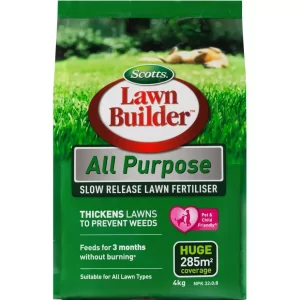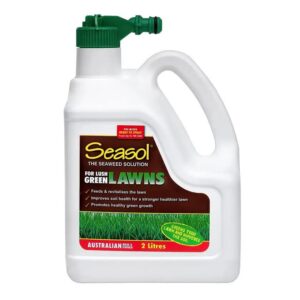Fertilizing
Fertilizing your lawn is a must if you want a lush green lawn all year-round.
Myself and many other professionals recommend using a slow release fertilizer twice a year. Once in Autumn to protect it from the cold wintry months, and another in spring to give it a boost for summer.
Next you will want to identify what type of lawn you have, this will help you pick the fertilizer you need. Common types include: Buffalo, Kikuyu, Couch or Zoysia. More on that Here!
Watering Habits
Before we dive into fertilizing, let's talk about watering habits. Many people neglect watering their lawns altogether, but if you want a healthy, vibrant lawn, watering is crucial. However, it's important to water wisely to avoid shallow roots that are more prone to disease and heat damage. Instead of watering every day or every other day, try to water heavily twice a week. This allows the roots to search for water and grow deeper into the ground, creating a more resilient root system.
Additionally, it's best to water in the early morning to prepare your lawn for the day ahead. Watering in the middle of the day can cause the sun to magnify through the water and scorch your grass, while watering too late can result in water sitting on your lawn overnight and promoting fungal growth.
These are simple tips, but they can make a big difference in the health and appearance of your lawn. With that said, let's get back to the topic of fertilizing
Liquid Vs Granular Fertilizers
Liquid Fertilizers:
Liquid fertilisers are a quick-acting alternative to granular fertilisers, as they are applied directly onto the lawn's foliage and are quickly absorbed. This leads to a rapid improvement in the lawn's appearance.
To ensure accurate application, it is crucial to measure your lawn's size and follow the recommended application rate for your chosen fertiliser. When applying the liquid fertiliser, it is recommended to walk in an organised manner to achieve an even application across the entire lawn.
It is also important to pay attention to the width of the sprayer to avoid overlapping and over-applying the fertiliser in certain areas.
To ensure accurate application, it is crucial to measure your lawn's size and follow the recommended application rate for your chosen fertiliser. When applying the liquid fertiliser, it is recommended to walk in an organised manner to achieve an even application across the entire lawn.
It is also important to pay attention to the width of the sprayer to avoid overlapping and over-applying the fertiliser in certain areas.
Granular Fertilizers:
Granular Fertilizers are a great option to choose. They are slow acting and feed your lawn over a extended period of time giving you a better looking yard all year round.
To apply the granules evenly, we suggest using a fertilizer spreader or using a smooth motion if spreading by hand. Even coverage is crucial when applying slow-release fertilizers, so we recommend walking up and down and across in opposite directions to achieve the best results.
Be sure to always water them in afterwards to prevent any tip burn, and get it working right away!

Tools And Materials
- Pair of gardening gloves. Such as these Lynn River Large Showa’s
- Pair of Glasses. Don’t want any of the fertilizer getting into your eye.
- A hand held fertiliser spreader. I recommend using something on the cheaper side if your doing just your own yard, like this: Scotts Handy Green Fertiliser Spreader
- Watering Can or Hose. This will be used to water in your grass after fertilising.
- Granular or Liquid Fertilizers.
Steps:
- Gather All Your Tools! This will include your fertilizer watering can, gloves and A fertilizer spreader.
- Choose From Chemical or Organic Lawn Care. Two types of lawn fertilizer exist: chemical and organic. Chemical lawn builders provide instant growth and green-up while organic fertilizers promote eco-friendliness and improve soil health. Additionally, there are two application methods: liquid and pellets. Pellets break down over time, allowing for a hands-off approach, while liquid requires more maintenance but provides quick results. To determine the best fertilizer for your lawn, check for hydrophobic soil by observing water behaviour when applied. If hydrophobic, use a wetting agent before fertilizing.
- Use a Lawn Spreader For The Granular Fertilizer. Try and pickup a spreader to help you evenly distribute the fertilizer. Other-wise you can end up with missing parts and other areas overgrown. If you do end up using your hand make sure to hold your hand flat shaken it evenly. AS-well as walking back and forth for maximum coverage.
- Water In The Fertilizer! This is where you can either use plain water from the tap, or choose to apply the liquid fertilizer at the same time. Most come with a attachment nozzle and spray evenly over your lawn.
- Clean-Up. That’s right everything is done just be sure to clean-up and water in your fertilizer. Be sure to check for application on the back of the packaging. This will be along the lines of, every 3-4 months of granular/ slow release fertilizer and 1-2 months for liquid.

[…] a healthy and vibrant lawn, be sure to check out some of our other blog posts, including those on Watering and Fertilizing. We’re committed to providing you with the most up-to-date and reliable information to help […]